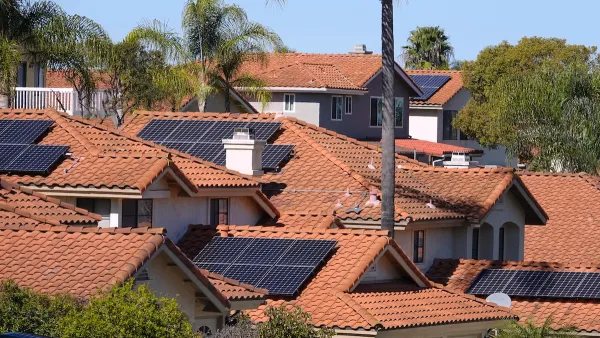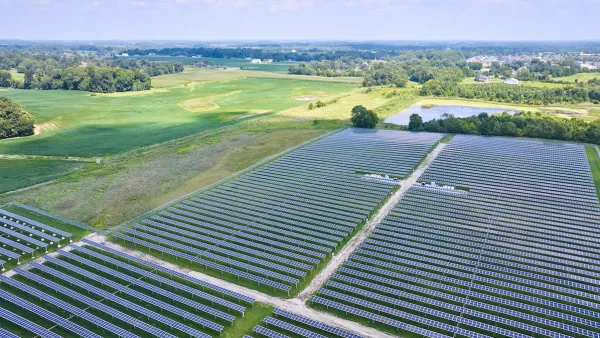What if most cars were electrics, most electricity was generated locally, and new development was required to have solar? Would this paradigm make sprawl more energy sustainable than compact growth? A new paper argues yes.
New research from "Professor Hugh Byrd (formerly with) the University of Lincoln (School of Architecture), UK, and collaborators including Professor Basil Sharp from the New Zealand Energy Centre and experts from the University of Auckland, New Zealand challenges the conventional theory that compact urban form offers the best solution for a sustainable city."
Rather than faulting the greater energy consumption associated with suburban development, the "researchers highlight the potential of suburbs for harnessing solar energy, with detached suburban houses capable of producing ten times the amount of energy created by skyscrapers and other commercial buildings."
The other aspect of energy where suburbs are faulted is their long commutes and increased local trips, but what if electricity was the predominant fuel?
While a compact city may be more efficient for internal combustion engine vehicles, a dispersed city is more efficient when distributed generation of electricity by photovoltaic installations is the main energy source and electric vehicles are the principal mode of transport.
Even in this "sprawl is good" land use scenario, city planners are needed. "If this energy contribution is to be effective, controls of new suburban development may be needed that require the installation of photovoltaic roofing, along with smart meters and appropriate charging facilities for vehicles. City planners will need to make the changes necessary to control suburban development."
The researchers see the energy potential of sprawling development as providing an energy source for center cities. From the abstract: "The purpose of this is to evaluate the contribution that electricity from PVs can make to reduce the electricity load of a city, supply the needs of a mixture of building types, reduce peak electricity demand and contribute towards the charging of electric vehicles (EVs)."
We may need some time to verify the findings. While EV sales are increasing, having "more than doubled in the U.S. during the first six months of 2013", according to AOL Autos associate editor Pete Bigelow, they "still represent only 1.23 percent of the total market". In addition, they are limited as to the range they travel, so it would seem we have a long ways to go to verify what the research shows about the energy sustainability of suburbs.
FULL STORY: Suburban Sprawl to Power Cities of the Future

National Parks Layoffs Will Cause Communities to Lose Billions
Thousands of essential park workers were laid off this week, just before the busy spring break season.

Retro-silient?: America’s First “Eco-burb,” The Woodlands Turns 50
A master-planned community north of Houston offers lessons on green infrastructure and resilient design, but falls short of its founder’s lofty affordability and walkability goals.

Delivering for America Plan Will Downgrade Mail Service in at Least 49.5 Percent of Zip Codes
Republican and Democrat lawmakers criticize the plan for its disproportionate negative impact on rural communities.

Test News Post 1
This is a summary

Test News Headline 46
Test for the image on the front page.

Balancing Bombs and Butterflies: How the National Guard Protects a Rare Species
The National Guard at Fort Indiantown Gap uses GIS technology and land management strategies to balance military training with conservation efforts, ensuring the survival of the rare eastern regal fritillary butterfly.
Urban Design for Planners 1: Software Tools
This six-course series explores essential urban design concepts using open source software and equips planners with the tools they need to participate fully in the urban design process.
Planning for Universal Design
Learn the tools for implementing Universal Design in planning regulations.
EMC Planning Group, Inc.
Planetizen
Planetizen
Mpact (formerly Rail~Volution)
Great Falls Development Authority, Inc.
HUDs Office of Policy Development and Research
NYU Wagner Graduate School of Public Service




























